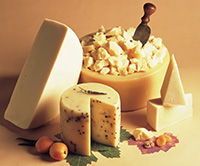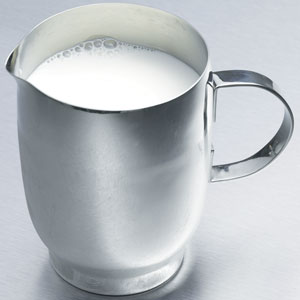 The U.S. dairy industry today applauded a commitment to stronger protections for common food names resulting from just-concluded trade talks with China.
The U.S. dairy industry today applauded a commitment to stronger protections for common food names resulting from just-concluded trade talks with China.
The favorable outcome of the U.S.-China Joint Commission on Commerce and Trade meetings should facilitate export of products like feta and parmesan cheese to China, which is a particularly large and fast-growing market for U.S. dairy products.
“We are extremely pleased that the United States and China have agreed to strong protections for products using these well-established cheese names as we seek to expand exports to this key market,” said Tom Suber, president of the U.S. Dairy Export Council.
“We especially appreciate U.S. negotiators’ recognition of the importance of common name preservation to U.S. exports and the heightened focus that the Obama administration has given to a key dairy industry priority,” added Jim Mulhern, president and CEO of the National Milk Producers Federation.
“The outcome of the JCCT meetings is a great example of the progress that can result from frank and productive collaboration between two trading partners,” said Connie Tipton, president and CEO of the International Dairy Foods Association.
The issue of common food names and their relationship to geographical indications (GIs) has generated considerable discussion this year due to European Union efforts to impose bans on the use of feta, parmesan, asiago, muenster and other common cheese names in international trade unless the products are manufactured in Europe.
The EU is using talks like those under way for a Trans-Atlantic free trade agreement to impose these bans. In addition, it is seeking GI-specific agreements with individual countries, including China. The U.S. dairy industry has strongly opposed EU efforts to impose these trade barriers as a way to limit global competition.
The JCCT result lays out common principles for how geographical indications should be handled, as well as a commitment to future dialogue on GIs between the two countries. The JCCT is a forum for addressing trade issues between the United States and China. The three days of JCCT meetings ended yesterday in Chicago.
For more information, read “U.S. Fact Sheet: 25th U.S.-China Joint Commission on Commerce and Trade.”
The National Milk Producers Federation, based in Arlington, Va., develops and carries out policies that advance the well-being of U.S. dairy producers and the cooperatives they collectively own. The members of NMPF’s cooperatives produce the majority of the U.S, milk supply, making NMPF the voice of nearly 32,000 dairy producers on Capitol Hill and with government agencies.
The U.S. Dairy Export Council is a non-profit, independent membership organization that represents the global trade interests of U.S. dairy producers, proprietary processors and cooperatives, ingredient suppliers and export traders. Its mission is to enhance U.S. global competitiveness and assist the U.S. industry to increase its global dairy ingredient sales and exports of U.S. dairy products. USDEC accomplishes this through programs in market development that build global demand for U.S. dairy products, resolve market access barriers and advance industry trade policy goals. USDEC is supported by staff across the United States and overseas in Mexico, South America, Asia, Middle East and Europe. The U.S. Dairy Export Council prohibits discrimination on the basis of age, disability, national origin, race, color, religion, creed, gender, sexual orientation, political beliefs, marital status, military status, and arrest or conviction record. www.usdec.org
The International Dairy Foods Association, Washington, D.C., represents the nation’s dairy manufacturing and marketing industries and their suppliers, with a membership of 550 companies representing a $125-billion a year industry. IDFA is composed of three constituent organizations: the Milk Industry Foundation, the National Cheese Institute and the International Ice Cream Association. IDFA’s nearly 200 dairy processing members run nearly 600 plant operations, and range from large multi-national organizations to single-plant companies. Together they represent more than 85 percent of the milk, cultured products, cheese, ice cream and frozen desserts produced and marketed in the United States. IDFA can be found at www.idfa.org.

 The National Milk Producers Federation said today a new food safety study from the U.S. Centers for Disease Control and Prevention presents a powerful argument against efforts to ease restrictions on the sale of raw milk to consumers.
The National Milk Producers Federation said today a new food safety study from the U.S. Centers for Disease Control and Prevention presents a powerful argument against efforts to ease restrictions on the sale of raw milk to consumers. Emily Metz Meredith, vice president for animal care at the National Milk Producers Federation, was honored today as a Rising PR Star by a leading newsletter for communications professionals.
Emily Metz Meredith, vice president for animal care at the National Milk Producers Federation, was honored today as a Rising PR Star by a leading newsletter for communications professionals. Farmers have two more weeks to sign up for the revamped dairy safety net included in the 2014 farm bill. The Agriculture Department extended the enrollment deadline for the
Farmers have two more weeks to sign up for the revamped dairy safety net included in the 2014 farm bill. The Agriculture Department extended the enrollment deadline for the  In early December, the House passed and sent to the Senate a one-year extension of more than 50 expired tax breaks, including an important one for farmers that NMPF strongly supported. The Senate is expected to pass the so-called “tax extenders” bill before adjourning for the holidays, but it is uncertain whether it will be identical to the House bill.
In early December, the House passed and sent to the Senate a one-year extension of more than 50 expired tax breaks, including an important one for farmers that NMPF strongly supported. The Senate is expected to pass the so-called “tax extenders” bill before adjourning for the holidays, but it is uncertain whether it will be identical to the House bill. In the wake of the Obama administration’s action last month to delay deportation for up to five million undocumented immigrants, NMPF joined other agriculture groups in re-emphasizing the need for comprehensive reform of the broken immigration system.
In the wake of the Obama administration’s action last month to delay deportation for up to five million undocumented immigrants, NMPF joined other agriculture groups in re-emphasizing the need for comprehensive reform of the broken immigration system. NMPF has held extensive consultations with key negotiators on the Trans-Pacific Partnership trade pact in advance of a meeting set for Washington during the second week in December. NMPF staff has been in constant communications with U.S. TPP negotiators, and traveled to China in November for discussions with U.S. negotiators and others involved in the Asia-Pacific Economic Cooperation forum.
NMPF has held extensive consultations with key negotiators on the Trans-Pacific Partnership trade pact in advance of a meeting set for Washington during the second week in December. NMPF staff has been in constant communications with U.S. TPP negotiators, and traveled to China in November for discussions with U.S. negotiators and others involved in the Asia-Pacific Economic Cooperation forum. During the month of November,
During the month of November,  NMPF has proposed a series of changes to the Environmental Protection Agency’s controversial Waters of the U.S. regulation, asking either that its recommendations be included in the current draft, or that EPA withdraw and rewrite the rule.
NMPF has proposed a series of changes to the Environmental Protection Agency’s controversial Waters of the U.S. regulation, asking either that its recommendations be included in the current draft, or that EPA withdraw and rewrite the rule.



